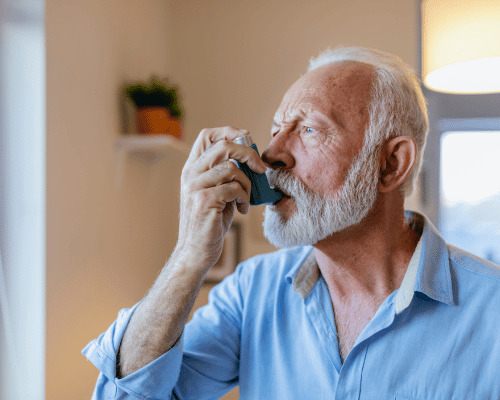In the fight against COPD, understanding how to optimize your inhaler use can lead to superior control over the disease. Dive in for a comprehensive look at tips, strategies, and evidence-based advice.
Understanding Chronic Obstructive Pulmonary Disease (COPD)
Chronic Obstructive Pulmonary Disease, commonly known as COPD, is a primary global health concern, affecting millions of people worldwide. Persistent respiratory symptoms and progressive airflow limitation primarily characterize this long-term lung disease. These are due to abnormalities in the airways or the alveoli, often induced by significant exposure to harmful particles or gasses.
Symptoms include shortness of breath, chronic cough, mucus production, and bouts of wheezing. Notably, the severity of COPD symptoms can vary from person to person and may fluctuate over time.
Medications, especially inhalers, play an important role when treating and managing COPD.
The Role of Inhalers in COPD Management
Inhalers are pivotal in the treatment and management of COPD. These portable devices allow medications to be delivered directly into the lungs, bypassing the digestive system. This delivery method allows for a rapid onset of action and minimizes systemic side effects.
Inhalers are used for maintenance therapy and quick-relief or "rescue" medications. By helping to open up airways, reduce inflammation, and even break up mucus, they alleviate symptoms, reduce the frequency and severity of exacerbations, and improve quality of life. However, the key to effective treatment is correct inhaler use.
Types of Inhalers for COPD
Several types of inhalers are used to manage COPD, each containing different types of medications.
Bronchodilators
Bronchodilators are medicines that relax bronchial muscles, dilating or widening the airways (bronchi) and making breathing easier. These are often the first line of defense against COPD. They come in two forms:
Short-Acting Bronchodilators (SABAs)
These provide quick relief from acute COPD symptoms. They're also known as 'rescue' medications.

Long-Acting Bronchodilators (LABAs)
These have a prolonged effect and are used for maintenance treatment in COPD. They help keep the airways open and reduce mucus.
Corticosteroids
Inhaled corticosteroids (ICS)
These are primarily used to decrease inflammation in the airways. They are usually prescribed in combination with LABAs for individuals who experience frequent COPD exacerbations.
Anticholinergics
Anticholinergics prevent the muscles around the bronchi from tightening, improving lung function and reducing COPD symptoms. They come as short-acting anticholinergics (SAAC) and long-acting anticholinergics (LAAC).
Essential Techniques for Optimizing Inhaler Use
The correct inhaler technique is crucial for effective treatment of COPD. If misused, much of the medicine may end up on the back of the tongue, mouth, or throat and not in the lungs where needed. Here are some steps to ensure optimal inhaler use:
Correct Positioning
Hold the inhaler upright when loading the dose. This ensures the correct amount of medication is loaded for inhalation.
Deep Inhalation
Take a deep breath and then breathe out completely to empty your lungs before using the inhaler. Then breathe slowly and deeply through the mouth as you trigger the inhaler, breathing in after the medication is released.
Holding Breath
After inhaling the medication, hold your breath for about 10 seconds (or as long as comfortable). This pause allows the medication to settle in your lungs, helping it to work effectively.
Mistakes to Avoid When Using Inhalers
Even though using an inhaler might seem straightforward, errors in usage are widespread. These mistakes can significantly decrease the effectiveness of the treatment. Here are some mistakes to avoid:
Not Shaking the Inhaler
Many inhalers, especially metered-dose inhalers (MDIs), need to be shaken before use to mix the medication properly.
Inhaling Too Quickly
If you breathe in too quickly when using the inhaler, the medication may end up in your mouth or the back of your throat and not in your lungs where needed.

Enhancing Inhaler Efficacy Through Breathing Exercises
Incorporating specific breathing exercises into your daily routine can enhance the effectiveness of the medication delivered by your inhaler. Techniques such as pursed-lip breathing and diaphragmatic (belly) breathing can significantly improve lung medication distribution.
Tips for Cleaning and Maintaining Your Inhaler
Proper cleaning and maintenance of your inhaler are essential to function effectively. Here are some tips:
Regular Cleaning
To avoid blockages caused by medication buildup, the inhaler's mouthpiece should be cleaned at least once a week.
Checking Expiry Date
Ensure that your inhaler has stayed active. An expired inhaler may not provide the correct dose of medication, reducing its effectiveness.
Frequently Asked Questions (FAQs)
How often should I use my inhaler?
The frequency of inhaler use can vary depending on the type of medication and the severity of your COPD. It's essential to follow your healthcare provider's instructions carefully.
What should I do if I experience side effects?
Consult your healthcare provider if you notice side effects such as a dry mouth, throat irritation, or an unusual taste. They can guide you on managing these effects or may adjust your medication.
Can I use someone else's inhaler?
No. It's essential only to use the inhaler prescribed to you. Other people's inhalers may contain different medications or dosages that may not suit your condition.
Mastering the technique of inhaler use and ensuring its regular maintenance is pivotal in achieving superior control of COPD. It's crucial to remember that each person's COPD is different, and hence the treatment plan, including the type of inhaler, can differ. By becoming more informed and proactive, you can significantly improve your quality of life with COPD.


